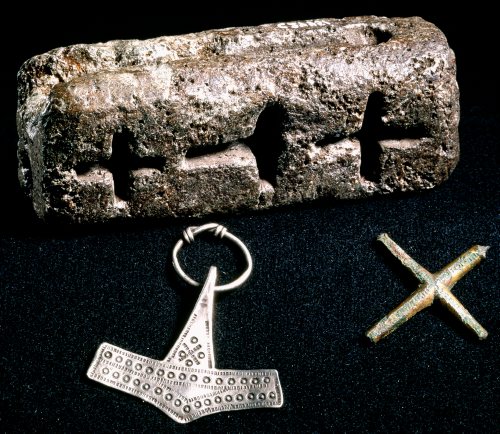As a military defence towards the south, a bank was built along the border – Dannevirke. The first part of these defences dates from as early as AD 737 and they were extended and strengthened throughout Viking times. Harold Bluetooth’s baptism can also be interpreted as a “religious” or political defence against the Germans. By allowing himself to be baptised and declaring Denmark to be Christian, he effectively removed the German-Roman Emperor's excuse for becoming involved in Danish internal politics or, more seriously, for invading the country.
The German church continued, however, to meddle. In both AD 965 and AD 988 it was decided that German bishops in Denmark should not pay tax to the Danish king. This was a blatant and rude intervention in Danish affairs.
England as an example
In the subsequent centuries, the Danish church attempted further to free itself from German influence. The archiepiscopal see in Hamburg-Bremen was originally given the Nordic Countries as its missionary area and exercised, at the end of the Viking Age, superiority over the Danish church. The Danish kings attempted to forge stronger bonds between the Danish church and the English church – which probably seemed natural given that England was in Danish hands from AD 1013 until AD 1042 and that there was close association throughout the whole of the Viking Age. Bishops and priests were taken to Denmark from England and the English architectural style was prominent in Danish stone churches at that time. Svein Estridson (AD 1047-74) also did what he could to make the Danish church independent of Hamburg-Bremen. But it was first under Eric I (Ejegod) (AD 1095-1103) that it proved possible to create a Danish archiepiscopal see.
Many Vikings probably just inserted the Christian God into their heathen mythology. They would not have wanted to give up the beliefs of their ancestors and the strong traditions and they did not perhaps have an understanding of Christian monotheism – that there was only one god. Many probably continued to worship their ancestors' gods in secret after the official conversion of Denmark to Christianity. In Iceland we know that it was the Alting – the Chieftains’s Council – which decided that people should become Christian. But at the same time it was also agreed that it was still permissible to believe in and worship the old gods – just not in public.
Christianity and foreign policy
The Christian church was a very strong power factor in Viking Age and Medieval Europe and in Denmark, the coming of Christianity is seen as being closely associated with foreign policy. The Vikings had become acquainted with Christianity through their travels and by way of Christian missionaries who journeyed to the Nordic Countries. But the final reason for Harold Bluetooth baptism was probably more political.
The Frankish threath
Denmark's greatest problem in Viking times was the Frankish Empire to the south, and later, after the division of the Frankish Empire, the German-Roman Empire. It was from here that, on many occasions through time, actions were taken involving internal Danish affairs, both secular and religious. Especially the fact that the Danes were heathens was used as a morally acceptable excuse for rulers of the day to invade other countries on the premise that they wished to convert the inhabitants to Christianity.
The missionaries who were sent to Denmark was very disliked. They were perceived as spies, or people who would create instability in the country. The surviving written sources concerning the missionaries do demonstrate that they encountered great resistance from chieftains and kings.
Read more about Christianity in Denmark here...
» Go to the next chapter 'The Viking Age Geography'...
Here you can read about how seafaring in the Viking Age transforms the world.
